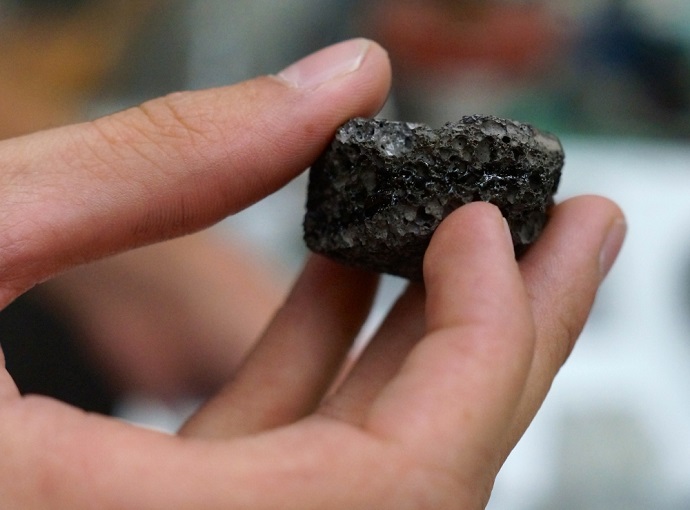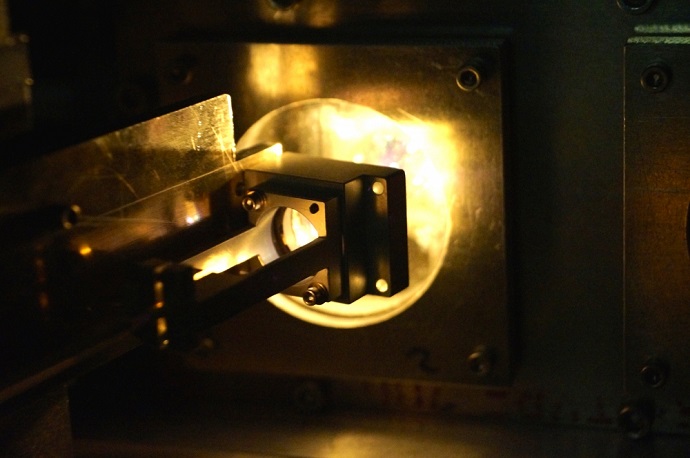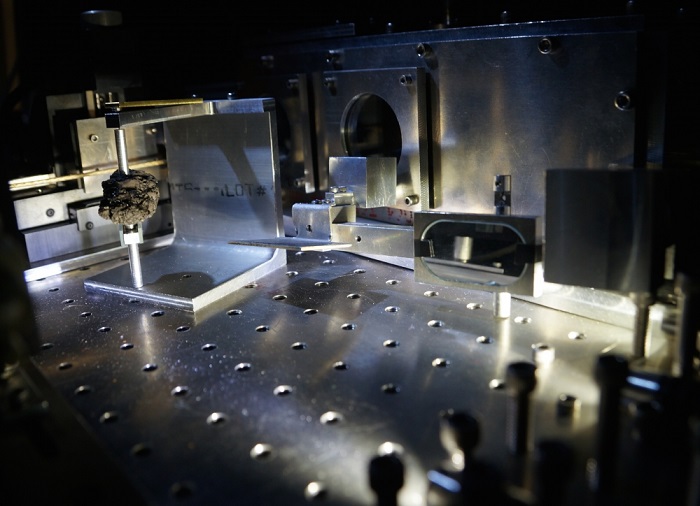August 27, 2015
By Julie Cohen
It’s the ultimate science fiction: The immense power of the sun is harnessed and converted into a massive phased array of laser beams that have the potential to intercept and deflect asteroids before they smash into Earth.
But in this case, fiction may actually be closer to reality. DE-STAR, or Directed Energy System for Targeting of Asteroids and exploRation, the brainchild of UC Santa Barbara physicist Philip Lubin and Gary B. Hughes, a researcher and professor at California Polytechnic State University, San Luis Obispo, is designed to do exactly that.
And that’s not all. The DE-STAR system could be leveraged for many other uses, such as stopping the rotation of a spinning asteroid and achieving relativistic propulsion. Now, students in Lubin’s Experimental Cosmology Group have produced graphic demonstrations of this and other possible functions — albeit on a much smaller scale in the lab.

The composition of basalt is similar to known asteroids.
Photo Credit: Sonia Fernandez
Deflecting Asteroids
To simulate a laser’s ability to deflect an asteroid, Travis Brashears led a group of students in tests that simulate space conditions. Using basalt — the composition of which is similar to known asteroids — they directed a laser onto the basalt target until it glowed white hot — a process called laser ablation, which erodes material from the sample. This changes the object’s mass and produces a “rocket engine” using the asteroid itself as the propellant. In space, this would be powerful enough to alter its course.
“What happens is a process called sublimation or vaporization, which turns a solid or liquid into a gas,” explained Brashears, now a freshman at UC Berkeley who started working in the lab during high school as part of UCSB’s Research Mentorship Program. “That gas causes a plume cloud — mass ejection — which generates an opposite and equal reaction or thrust — and that’s what we measure.”
De-Spinning Asteroids
Then the team simulated a spinning asteroid using basalt to determine whether they could slow, stop and change its rotation direction. They used magnets to spin the basalt and then directed the laser in the opposite direction to slow the rotation.
“Our video shows the basalt sample slowing down, stopping and changing direction and then spinning up again,” said Brashears. “That’s how much force we’re getting. It’s a nice way to show this process and to demonstrate that de-spinning an asteroid is actually possible as predicted in our papers.”
According to Lubin, a professor of physics at UCSB, manipulating the speed of a spinning asteroid offers another important possibility in space: the ability to explore, capture and mine asteroids. This is something NASA aims to do with its Asteroid Redirect Mission. The mission — which remains theoretical — is intended to visit a large near-Earth asteroid, collect and return a boulder from its surface and possibly redirect the asteroid into a stable orbit around the moon.
“All asteroids rotate; it’s just a question of relative to whom and how fast,” explained Lubin. “To mine an asteroid, it needs to be moving slowly enough so you can capture it. Our lab experiments show very graphically a practical way to de-spin or redirect an asteroid. It’s a vivid demonstration that the technique works very well.”

The laser is focused on the basalt to manipulate its movement.
Photo Credit: Sonia Fernandez
Photon Propulsion
In addition, the students explored photon propulsion, which is key to the group’s latest project, DEEP-IN, or Directed Energy Propulsion for Interstellar exploratioN. The DEEP-IN concept relies on photon propulsion, whereby thrust from photons emitted from the laser array could be used to propel a spacecraft. This allows for the possibility of relativistic flight — speeds approaching the speed of light — for the small spacecraft required for future interstellar missions.
The team also tested a photon recycler, a device that reuses photons from the laser by shining them on a reflector cavity. “We have a second mirror at some distance away that bounces the photons back and forth like a ping-pong ball onto the spacecraft reflector.” Brashears said. “In effect, we’re recycling these photons to achieve a force multiplication that allows the vehicle to go even faster. So far, with a simple implementation, we have achieved an amplification factor of five. Much more is possible with refinement. This works as predicted, though implementing it into the full flight system will be complex.”
Targeting Asteroids from UC Santa Barbara on Vimeo.
UCSB’s Experimental Cosmology Group graphically demonstrates its DE-STAR system.















